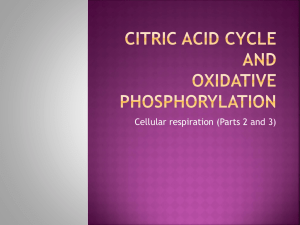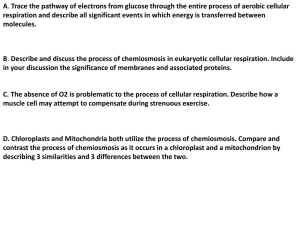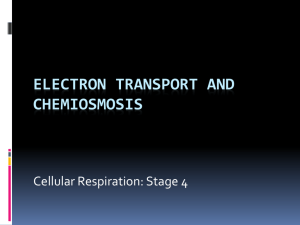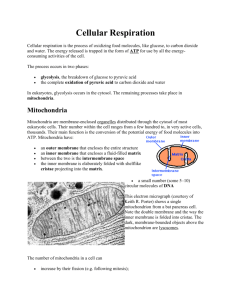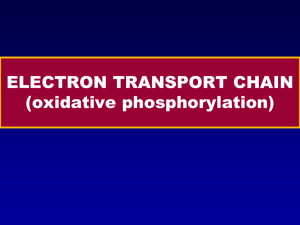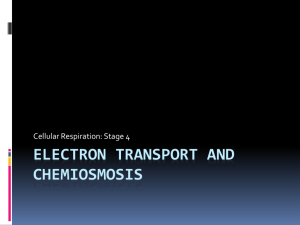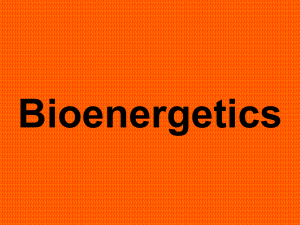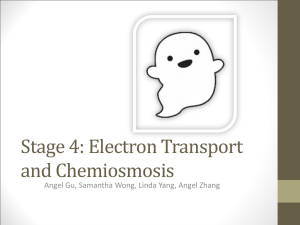Electron Transport Chain and Chemiosmosis
advertisement
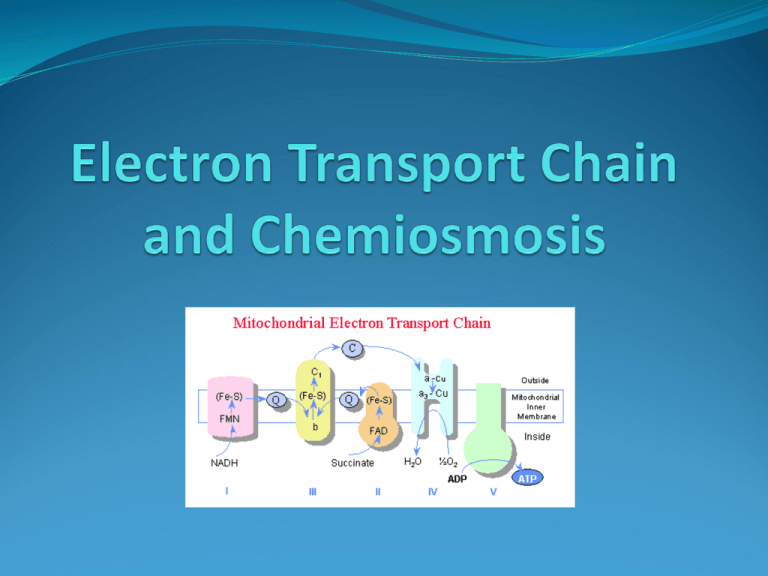
Introduction to the ETC The electron carrying molecules, NADH and FADH2, transfer their electrons to a series of compounds (mostly proteins), which are associated with the cristae. How it Works The protein/compounds are arranged in order of increasing electronegativity… therefore each successive compound wants the electrons more than the one before it. How it Works The compounds: NADH dehydrogenase, ubiquinone (Q), the cytochrome b-c1 complex, cytochrome c, cytochrome oxidase complex. How it Works Each compound is reduced by gaining two electrons from the one before it and oxidized by donating its two electrons to the one after it. How it Works As the electrons are passed they become more stable and therefore generate free energy. How it Works This free energy is used to pump protons into the intermembrane space from the matrix (Active transport). There are three proton pumps. Oxygen is the final electron acceptor and it joins with two protons in the matrix to form water. Steps for NADH NADH gives up its two electrons to NADH dehydrogenase. Steps for NADH The mobile carriers Q and cytochrome c shuttle electrons from one protein complex to the next until they reach the final protein complex, cytochrome oxidase. Along the way, as the electrons lose energy and become more stable, 3 protons are actively transported from the matrix into the intermembrane space. Steps for NADH Here part of the cytochrome catalyzes the reaction between the electrons, protons and oxygen to form water. Steps for NADH This process is highly exergonic (giving up free energy 222kJ/mol)… the chemical potential energy of electron position is converted to electrochemical potential energy of a proton gradient that forms across the inner mitochondrial membrane. This energy will be used to power ATP synthesis in chemiosmosis. Electrochemical Gradient Intermembrane space Cristae Matrix Path of FADH2 FADH2 skips the first protein compound. This means that FADH2 oxidation pumps two protons into the intermembrane space. Three ATP are formed from the electrons from NADH while only two ATP are formed from the electrons from ATP FADH2 as they begin with lower energy. NADH from Glycolysis Important to note that the NADH formed in glycolysis in the cytoplasm passes into the mitochondrial matrix through the glycerol-phosphate shuttle, where its electrons are passed to FADH2, therefore FADH2 essentially is created in glycolysis, therefore two ATP are formed from that electron carrying molecule. NADH from Glycolysis There is another way that NADH can pass its electrons to another NAD+ instead of FAD… it is the aspartate shuttle, but we will just assume this one does not exist. There are many copies of the ETC along the cristae; therefore lots of ATP can be produced. Chemiosmosis and Oxidative Phosphorylation There is an electrochemical gradient across the cristae. (More protons outside than in the matrix) Two parts: difference in charge and a difference in concentration. Electrochemical Gradient Intermembrane space Cristae Matrix Chemiosmosis and Oxidative Phosphorylation The inner membrane is impermeable to protons. The protons are forced through special proton channels that are coupled with ATP synthase (ATPase). Chemiosmosis and Oxidative Phosphorylation The electrochemical gradient produces a proton-motive force (PMF) that moves the protons through this ATPase complex. Chemiosmosis and Oxidative Phosphorylation Each time a proton comes through the ATPase complex, the free energy of the electrochemical gradient is reduced and this energy is used to create ATP from ADP + P in the matrix. Chemiosmosis and Oxidative Phosphorylation Peter Mitchell found all this out in 1961 and coined the term chemiosmosis because the energy that drives ATP production comes from the osmosis of protons. It took a long time for his theory to be accepted. He finally got his Nobel Prize in 1978. It is about time! Chemiosmosis and Oxidative Phosphorylation The continual production of ATP is dependent on the maintenance of a proton reservoir in the intermembrane space. This depends on the continued movement of electrons and that depends on the availability of oxygen. Therefore we need oxygen to prevent the ETC from being clogged up and we need food to provide the glucose that provides electrons for the ETC. REVIEW THIS!!!

